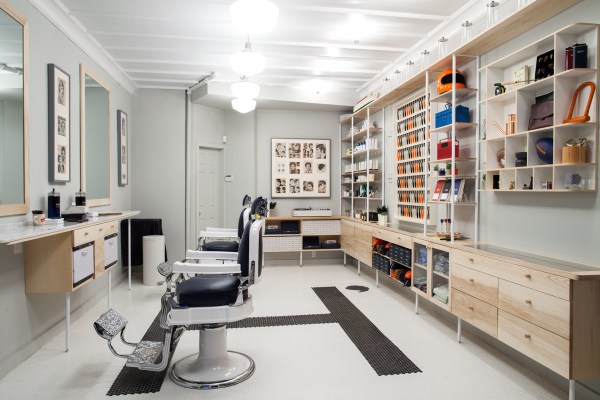Months after Warby Parker opened its flagship store in New York, co-founder Jeff Raider is taking his other venture, Harry’s, in a brick and mortar direction as well. Tomorrow, the shaving supply startup will open the doors of its “Corner Shop,” a barbershop-slash-retail location in SoHo.
The small, airy shop houses two barber chairs with old school engraved footrests. Behind them there’s a wall of glossy razor handles in bright orange and navy and a pared-down selection of grooming products. It’s cool, even if the decorative copies of “How to Stay Alive in the Woods” and “The Craft of the Knot” feed the gentlemanly vibe a bit obviously. Customers can book a haircut and shave online, or just swing by the shop for an appointment.
The shop accomplishes a few things. It’s a brand experience that moves product in the moment and immerses the customer in the aspirational Harry’s lifestyle. And, with the help of a companion app for the barbers, it closes the loop on offline and online customer behavior.
Designed by Gin Lane, the app is kind of brilliant. A barber take a picture of his client’s haircut, which gets added to an online profile to pull up the next time he drops by. In short, you can get the same haircut you had a year ago without trying to stumbling through a verbal explanation of it. Thus making us all wonder why every salon doesn’t have this.
It also means that if a customer purchased a razor on the website, his barber can make in-person recommendations based on that. It’s a lightweight way of incorporating digital into the in-store experience that’s both useful to the customer and helps Harry’s do better cross-marketing.
“A lot of brands want to know your order history. When I walk into J.Crew, the associate doesn’t know that I spent thousands of dollars online,” Gin Lane digital creative director Dan Kenger said. “It’s like CRM for barbers.”
Version one is meant for use by the barbers, allowing them to create a customer profile, look them up later, save photos, and add notes. As they build it out, they’ll be adding more features to close the gap between the online and offline experience for the consumer.
The move offline begs a comparison to Warby Parker’s flagship store – I did it in my lead sentence! — but though both offline locations pay scrupulous attention to design detail, the intention is quite different, Raider said.
“Where it diverges is that at Warby Parker, it’s a traditional store. They order online, and we ship it,” Raider said. “Here it’s an experience. That’s a pretty different model.”
While there’s a certain practicality to the barbershop — every guy needs to get a haircut now and then — it’s really an approach to infusing commerce with content, the content here being the full, immersive experience of a lifestyle brand. In that same vein, Harry’s also publishes an online magazine, titled 5 o’clock and edited by GQ writer Sean Hotchkiss. But the barbershop helps Harry’s deliver an end-to-end experience.
Raider didn’t give numbers on Harry’s sales or monthly uniques at this point, but did say that they’re pretty far ahead of where they expected to be at this point.
In the interest of keeping the in-store experience special and aligned with the feel of the neighborhood, Raider said that the long term scale of the Harry’s shops would be somewhere in the range of five locations, not more than twenty.
“I wouldn’t rule out another retail location in the next year,” he said.
